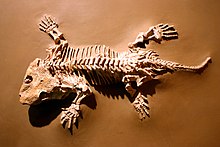Anthracosauria
| Anthracosauria | |
|---|---|

| |
| The skeleton of Seymouria baylorensis | |
| Scientific classification | |
| Domain: | Eukaryota |
| Kingdom: | Animalia |
| Phylum: | Chordata |
| Clade: | Sarcopterygii |
| Clade: | Tetrapodomorpha |
| Clade: | Stegocephali |
| Order: | Anthracosauria Säve-Söderbergh, 1934 |
| Subgroups | |
Anthracosauria is an order of extinct reptile-like
lissamphibians such as frogs and salamanders. An equivalent term to this definition would be Reptiliomorpha. Anthracosauria has also been used to refer to a smaller group of large, crocodilian-like aquatic tetrapods also known as embolomeres
.
Various definitions

As originally defined by
labyrinthodont" reptile-like amphibians, and Säve-Söderbergh's definition is more equivalent to Romer's suborder Embolomeri. This definition was also used by Edwin H. Colbert and Robert L. Carroll
in their textbooks of Vertebrate Palaeontology (Colbert 1969, Carroll 1988). Dr A. L. Panchen however preferred Säve-Söderbergh's original definition of Antracosauria in his Handbuch der Paläoherpetologie, 1970.
With
paraphyletic order within the superorder Reptiliomorpha, along with the orders Seymouriamorpha and Diadectomorpha, thus making the Anthracosaurians the "lower" reptile-like amphibians. In his definition, the group encompass the Embolomeri, Chroniosuchia and possibly the family Gephyrostegidae
.
Many studies since have suggested that anthracosaurs or embolomeres are likely
reptiliomorphs closer to amniotes, but some recent studies either retain them as amphibians or argue that their relationships are still ambiguous and are more likely to be stem-tetrapods.[1][2][3]
Etymology
The name "Anthracosauria" is
Coal Measures
.
References and external links
- Benton, M. J. (2004), Vertebrate Palaeontology, Blackwell Science Ltd 3rd ed. - see also taxonomic hierarchy of the vertebrates, according to Benton 2004
- Carroll, R. L., 1988: Vertebrate Paleontology and Evolution. W. H. Freeman and company, New York
- Clack, J. A. (2002), Gaining Ground: the Origin and Evolution of Tetrapods Indiana Univ. Press, 369 pp.
- Colbert, E. H. (1969), Evolution of the Vertebrates, John Wiley & Sons Inc (2nd ed.)
- Gauthier, J. A.; Kluge, A. G.; Rowe, T. (1988). "The early evolution of the Amniota". In M. J. Benton (ed.). The Phylogeny and Classification of the Tetrapods, Volume 1: Amphibians, Reptiles, Birds. Systematics Association Special Volume. Vol. 35A. Clarendon Press. pp. 103–155.
- Laurin, Michel (1996) Terrestrial Vertebrates - Stegocephalians: Tetrapods and other digit-bearing vertebrates
- Michel Laurin (2001). "L'utilisation de la taxonomie phylogénétique en paléontologie: avantages et inconvénients". Biosystema. 19: 197–211.
- Palaeos Anthracosauroidea
- Panchen, A. L. (1970) Handbuch der Paläoherpetologie - Encyclopedia of Paleoherpetology Part 5a - Batrachosauria (Anthracosauria), Gustav Fischer Verlag - Stuttgart & Portland, 83 pp.,
- Marcello Ruta, Michael I. Coates and Donald L. J. Quicke (2003). "Early tetrapod relationships revisited" (PDF). Biological Reviews. 78 (2): 251–345. S2CID 31298396.
- Systema Naturae 2000 / Classification Order Anthracosauria
Citations
- ^ Hodnett, John-Paul M.; Lucas, Spencer G. (2018). "A nonmarine Late Pennsylvanian vertebrate assemblage in a marine bromalite from the Manzanita Mountains, Bernalillo County, New Mexico". New Mexico Museum of Natural History and Science Bulletin. 79: 251–260.
- ^ Adams, Gabrielle R. (2020). "3. A phylogenetic analysis of NSM 994GF1.1 to determine the placement of embolomeres in the tetrapod tree". Description of Calligenethlon watsoni based on computed tomography and resulting implications for the phylogenetic placement of embolomeres (MSc thesis). Carleton University.
- .
